Hamartia Antidote
ELITE MEMBER

- Joined
- Nov 17, 2013
- Messages
- 35,188
- Reaction score
- 30
- Country
- Location
Follow along with the video below to see how to install our site as a web app on your home screen.
Note: This feature may not be available in some browsers.






Hey bro, up late like me ey? I saw your earlier tag I was just too beat from all the stress of following the genocide in Gaza bro. The endless pics of the children is really wearing on me plus we have friends who barely got out of there by the skin of their teeth. Now I can hardly keep my eyes open lol. I saw the video in your OP when I got your tag, but I'll take a better look first thing tomorrow fo sho and get into this shite, who doesn't love this crap even guys like me who grew up with those things right out my window for many years. Like anything else, when it's in your backyard you don't realize the significance. But the history is mesmerizingly enchanting, no doubt.

@Gomig-21 I don't understand what the big mystery is on how they built the pyramids. The ancient Egyptians had cattle and it seems in the grand scheme of things that it wouldn't take much effort to yoke up say 10 teams of 15 animals to thick ropes that were looped up and over from one side of the pyramid to the other to haul up even the heaviest block with teams of men simply making sure to keep the contact points of the rope on the pyramids greased. 150 oxen I'm sure could haul up a heavy single block with relatively minimal effort.
Infact they could continuously walk the cattle in large circles so when they are walking away from the pyramid they pulled up the blocks but when walking back towards the pyramids the rope would slacken and they could have another smaller team on the other side pull the slack back over where men could then tie it to the next block and repeat the process endlessly in one big assembly line.
Or better yet they had 150 oxen on both sides tied to the same rope with the block carrier tied in the middle. The blocks would be pulled up on both sides with men loading the blocks at the base of each pyramid side.. So when one team is walking away from the pyramid pulling a block up the other team is walking towards the pyramid managing the slack. Then as both oxen teams turn their circles the opposite team does the pulling while the other handles the slack.
You get this "machine" working in sync you could get 1 block up at the speed it takes an oxen team to walk the length of the slope of the pyramid.
You could have another 2 teams working the other two sides.
You could also keep a few strong bulls on the actual pyramid too 24/hrs a day to help drag the stones close to the placement point. The work gangs would only need to be there to leverage the stones the final few inches.
I bet many of the human workers at the site


That video author had some great insight on the construction methods. That was very interesting how he took the visual aspect of how the stones were lined up in not just Khafra, but the Stepped & Red pyramids also. Taking into account all the different lengths and their respective locations which would certainly give clues to the construction method. I don't think that much level of detail on the stone blocks themselves had been done before TBH, at least not that I'm aware of.
I think he was just frustrated that nobody seems to have gone though the trouble of mapping the stones yet tons of people were pushing hypothesis about ramps and stuff.He figured the longer blocks were used at the corners as well as the center of each row and then the filler blocks in between which makes perfect sense. He must be an architect, even a mechanical engineer or something along those lines to observe then analyze those kind of details and come up with hypothesis.
The only thing I would challenge is that he figured, based on that fact of the larger and cut at angle stones placed at the corners were shaped & cut then hoisted (with whatever method) and installed then the center blocks the same followed by the subsequent smaller filler blocks and I would say there is a strong possibility that they might've actually cut the final angled cutes and even polished the stoned at the top level right before pushing them into place.
I'm even thinking there's a strong possibility that the corner blocks might've been installed longer in size and then with a chalk line or string marker of some kind, snap a line with the corresponding angle then cut it in place. What do you think of that?
Before getting into the crux of your post (which is awesome BTW), I'm wondering why you're making the point of prefixing the word "workers" with the word "human"? Is it because you're making the distinction between the oxen and humans or were you hinting at the theory of "aliens" having built the damn things?

Good stuff. The age-old mystery of how the pyramids of Giza were built.
One of the craziest theories I heard was that the blocks were raised using ancient parachutes. Some nutty dude came out (I even think it was on PBS which I don't believe ever indulges in ludicrous theories so it was strange) and figured the AEs (Ancient Egyptians) used large segments of cloth tied with ropes at several points and would anticipate strong winds to lift the blocks. At the same time, used additional ropes manned by men who handled the direction of the flying blocks to get them roughly at the desired spots and then just levered them into place.
Definitely thinking outside the box but a bit too far-fetched for me TBH.


Well this all entails risk. It seems the final smoothness wouldn't be done at the bottom if there was a chance a block could get chipped on the way up. Also you have to expect that occasionally a hoisted block would end up bouncing down the side due to an accident and any smoothness work done to the casing stones below would get ruined. How the heck would you fix it? A true nightmare scenario.
I think it would be too risky to perfectly smooth them as the pyramid was built as just one fallen block could ruin the surface. I would also expect a Pharoah anyway at the end to see imperfections and order some touching up so they'd have to have a way of people rappelling down the sides to smooth things out like a bunch of window washers.
I think that sounds logical. However remember they have to get rid of the debris somehow too..and how are they going to throw it over the edge without ruining the white casing stones below. This makes me think one side was left exposed the entire time for a chute
 Thank God was looking out for me. That thing not only would've caused major damage but hurt someone badly. Either Mickey in the dumpster or the neighbors who were within distance. Needless to say, it was the talk of the neighborhood for the rest of the months that we were on that site! lol.
Thank God was looking out for me. That thing not only would've caused major damage but hurt someone badly. Either Mickey in the dumpster or the neighbors who were within distance. Needless to say, it was the talk of the neighborhood for the rest of the months that we were on that site! lol.No aliens. The Egyptians just cut/smoothed the blocks and moved them the last few inches. The oxen did 99% of the block moving work.

Which lends credence to my theory that I've maintained for a long time, since I've been heavily involved in the construction business as well as wood carving artwork and that is the standard sculpturing method. That is get them all up there in an overall rough compilation (to avoid all the issues you just mentioned since they're very legitimate concerns) and then refine the entire shape, just like sculpting.
When you look at many of Micheal Angelo's marble sculptures, he basically followed that pattern of sequence. That would actually make the final accuracy much easier and better to achieve.
View attachment 968864
Granted this is on a much smaller scale than the pyramids, but it follows the same principle. It would actually make the process much easier, and more accurate in the long run.
One of the biggest points of contention was how the hell did they achieve those absolutely perfect corners from the base to the point? If you stood at the bottom and looked up one of any corners, even with the casing stones gone for the most part, you can tell those lines are perfectly straight.
and the bottom end dropped into the dumpster, fluttered to the left and to the right for a couple of seconds and then just folded over perfectly right into the dumpster!
And also like you & the narrator Dr. said, building ramps of any type would almost be just as laborious as the building the pyramids themselves since they'd have to be large and long enough to access different heights as well as having to frequently add to them as the height increases. Wouldn't make sense.

Simple. They measured four identical rope lengths and attached them to a ring. The other ends were put in the four bottom corners on poles with winches. The ring will end up in the middle. They tightened the winches the exact same amounts. When it was tight this gave them the center. They put a pole through the ring and into the base pyramid foundation. They they let out the rope exact amounts and raised the ring to see if the pole was straight up. The also used weights on ropes hanging off the sides to make sure the pole was straight. The rope was always above the heads of the workers. They had work bosses on platforms behind the rope making sure the corners were straight going up.

| | 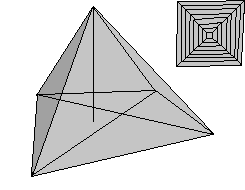
|
| Center The center of the pyramid is moved to the side. The pyramid looks lopsided. | Right angles If the angles are not the same (for example 90°), the center of the pyramid moves and the overall shape is distorted. | |
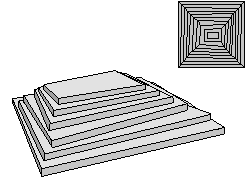
| | 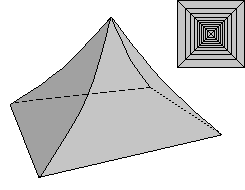
|
| Edges / Corners The edges are not positioned in such a way as to form in a constant angle. The shape of the pyramid is totally distorted. The stones lying in the very middle and the corner stones were layed down specially carefully and then those stones would provide a guide to ensure the geometrical accuracy of the four right angled corners and the outer stones between. [3]. | Angle of inclination If the angle of inclination is not controlled the lateral surfaces of the pyramid are either convex or concave. This was guaranteed, if the outer stones were cut already to the right angle in the quarry and were strictly controlled before they were brought to the pyramid. | |
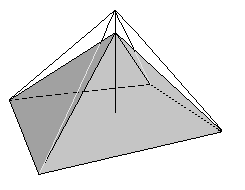
| | 
|
| Height and base The pyramid is determined by its height and the base. | Smoothness The casing blocks have to present a smooth lateral surface. To achieve this the outer stones were specially well polished and all the joints filled. | |
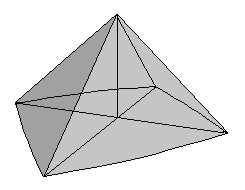
| | 
|
| Stability For more stability some stone layers are slightly tilted towards the center | Alignment For religious reasons the pyramids on the Giza plateau are all aligned exactly north-south and in relation to each other |


Mmmm.......interesting theory. So the pole would start where at the center of the pyramid foundation and extend all the way up to the eventual final height of the pyramid? Then the ring is raised up the pole to that top point which in the case of Khufu would have to be 481 feet tall. Not sure they could manufacture a pole that long unless I'm misunderstanding what you're describing which is probably the case lol. Or you're saying that the pole is a manageable length, and they just keep raising it incrementally until they reach the final height? But that wouldn't give them the base angle at which to start the corners. That angle is the same and is consistent from the start at the base of the corners all the way up to the peak. If they only raise the ring incrementally, that will give them a different angle, nowhere close to actual one until they reach the top. Not sure how that would work. I'm probably misunderstanding you is my guess.
To me, they would need to maintain a constant angle of inclination in the 4 corners (51.84° which ended up being the case) from the base of the 4 corners to the peak. Scientists/Egyptologists call them ridges but it's easier for layman to call them corners. That in of itself is a monumental task, no pun intended, let alone maintaining the angle of inclination at the center of the 4 walls which is a different angle than the corners.
Whatever the solution was, it couldn't have been an easy one, not only to figure out, but to execute considering the consequences could be disastrous, like in this illustration which also highlights other major considerations such as the consequences of not having a perfectly square base foundation from the start.


Center
The center of the pyramid is moved to the side. The pyramid looks lopsided.Right angles
If the angles are not the same (for example 90°), the center of the pyramid moves and the overall shape is distorted.

Edges / Corners
The edges are not positioned in such a way as to form in a constant angle. The shape of the pyramid is totally distorted. The stones lying in the very middle and the corner stones were layed down specially carefully and then those stones would provide a guide to ensure the geometrical accuracy of the four right angled corners and the outer stones between. [3].Angle of inclination
If the angle of inclination is not controlled the lateral surfaces of the pyramid are either convex or concave. This was guaranteed, if the outer stones were cut already to the right angle in the quarry and were strictly controlled before they were brought to the pyramid.

Height and base
The pyramid is determined by its height and the base.Smoothness
The casing blocks have to present a smooth lateral surface. To achieve this the outer stones were specially well polished and all the joints filled.

Stability
For more stability some stone layers are slightly tilted towards the centerAlignment
For religious reasons the pyramids on the Giza plateau are all aligned exactly north-south and in relation to each other
This is identical to what we face when building hip roofs. Your angles at the hip and valley rafters are much steeper than your joist rafters. It's a fascinating geometric concept that can be brutally hard to understand and learn, but once you get it, it's like riding a bike.
It also baffles the mind at how intelligent these people were. The fact that the three main pyramids are perfectly lined up with north to south cannot be a coincidence. Did they really take astronomy and were able to apply it geographically? Ancient Global Positioning Stars?
View attachment 968895

What about squaring the base foundation? Without any modern tools, there is a rather simple way to do it just with measurements which is certainly something they were able to do using some type of measuring tape. Most likely rope just like early sailors used knots tied incrementally on ropes to dictate a standard distance to determine the depth of waters. Each distance was a fathom and so it only makes sense the AEs used rope to not only measure lengths & distances, but to determine right angles to square up the pyramid's foundations.
By stretching a cord between two pegs stuck in the ground, a long straight line was marked out. Then to each peg an equal length of string was tied, more than half as long as the line drawn. By keeping the strings stretched tight and moving the ends around, the Egyptians could draw parts of two perfect circles. These arcs cross each other at two points. By drawing a straight line between these two points the original line is bisected at a right angle and the line is cut into two equal parts. Then you get a perfect right angle.
View attachment 969205
When we're checking framing squareness of floors and walls, we use a tape measure and use the 3-4-5 rule. Say you have a corner of a deck and you want to check if it's square, you measure one side and make a mark at 3 ft, measure the next side and make a mark at 4ft then measure between those two marks and 5ft would be a perfect right angle. If it's off, you shift the deck perimeter frame (or walls) until that distance is exactly 5ft.
View attachment 969217
If the frame/area is large and 3-4-5 limits rule is limiting, then you simply double up on each number until it works better. 6-8-10 and so on.
This could very well be a rule they used or at least were aware of which if you think about, is remarkable in of itself.
